For SEO-driven organizations, content creation can consume a marketer’s sole focus. When buried in copy, it’s easy to overlook internal links.
Links signal the importance of pages to search engines. Unlike external links from other domains, you have full control over internal links. And when used purposefully, a well-defined internal linking strategy can boost rankings across the board.
If you’re looking to build authority for your most important pages, refreshing your internal linking strategy is a great place to start.
This post breaks down key concepts related to internal linking, how to conduct an internal link audit and tips for building an airtight strategy to maximize their effectiveness.
What Are Internal Links?
Internal links are hyperlinks that let users navigate between pages on a single domain.
These structures improve the user experience, allowing users to browse logically and quickly access what they need.
A website’s main navigation and footer are perfect examples of internal linking. The main navigation organizes a site’s most important pages and allows users to drill into pages directly from the homepage.
On-page links are another example. You can link text on a page to another related page to provide further context around a topic.
Linking relationships create a hierarchy and point search engines to your most important pages to surface in SERPs.
Why Are Internal Links Important?
When evaluating websites for SERPs, Google places a higher value on pages with more internal links.
The number of internal links to a page is a powerful ranking factor that affects:
- Page authority: Like external links, internal links also pass SEO juice that helps Google discern your high-authority pages. The number of links to a page signals its relative importance to all pages on your domain and affects its “authority.”
- Crawling: Do your pages take months to move up the SERPs? Internal links alert search engines to your pages faster, allowing them to get discovered and crawled sooner.
- Site architecture and user experience: An organized site architecture improves the user experience, allowing users to quickly find important pages.
Most importantly, adhering to an internal linking strategy is a relatively quick task that can significantly impact your organic SEO rankings.
How Do You Audit Internal Links?
Before linking between pages, you need to understand your starting point with an internal link audit.
When conducting your audit, document these criteria:
1. Crawl Depth
How many clicks does it take a user to find the page?
A page’s distance from the homepage (the most authoritative page in a site hierarchy) affects its SEO value, according to Google’s John Mueller. Search engines see buried content as lower authority.
Use tools like SEMrush or Screaming Frog to measure crawl depth to your pages, and export the data.
Filter pages by their crawl depth, and flag important pages with high crawl depth (further from the homepage) to address. In general, you should aim for 3 clicks or fewer.
2. Internal Links
How many internal links does each page receive?
Use the same tools in step one to discover the number of internal links to each page.
Look for pages with too few (or too many) internal links to correct. Keep a close eye on:
- Orphan pages: In general, you want to avoid orphan pages (those with zero internal links) and limit internal links to 100.
- Unimportant pages with a large amount of links: Why do links to unimportant pages matter? Remember: Your internal links alert search engines to your most important pages. When pointing more pages to low-value or irrelevant pages, search engines will pay more attention to these pages than those you actually care about. Make it as easy as possible for search engines to determine your most important pages.
- Low-quality or irrelevant links: As you evaluate internal links, take note of links that don’t relate to the topic of the page they appear on. Links should add context to the page's content and allow readers to drill deeper into a related topic.
3. Internal Links Issues
Links that return an error weaken the user experience and can affect your SEO standing.
When auditing your internal links, look for the following link issues to address:
- Broken links (4xx error)
- Internal links to redirected pages (3xx)
The Best Internal Linking Strategy
You’ve documented issues with internal links. Now it’s time to outline your internal linking strategy and make the necessary changes.
The best internal linking strategy focuses on grouping related pages around topics.
Known as the topic cluster strategy, this approach uses internal links to point related pages to your most important ones to build their authority.
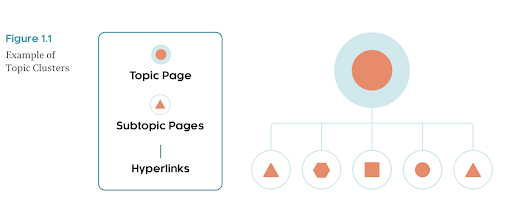
Linking related pages helps search engines better understand what your website is about and easily see the relationships between your content. Linked subtopic pages also add context to your topic pages, helping search engines better understand their place in SERPs.
Plus, these linking relationships transfer authority to your most important pages to boost their search rankings.
With a complete topic cluster strategy in place, your site architecture appears more structured and organized around your most important topics:

Ready to implement your own topic cluster strategy?
Here’s how to build an effective internal linking strategy using the topic cluster model:
1. Define Your Topic Clusters
When organizing existing content around topics, start with the most important pages that you want to rank in search results.
These might include your product or services pages or long-form blog posts that touch on important topics related to your offering.
For example, if you sell deodorant or antiperspirant, that’s a great place to start.
Use a free tool like Blueprint SEO to document your topics and quickly attach their URL:
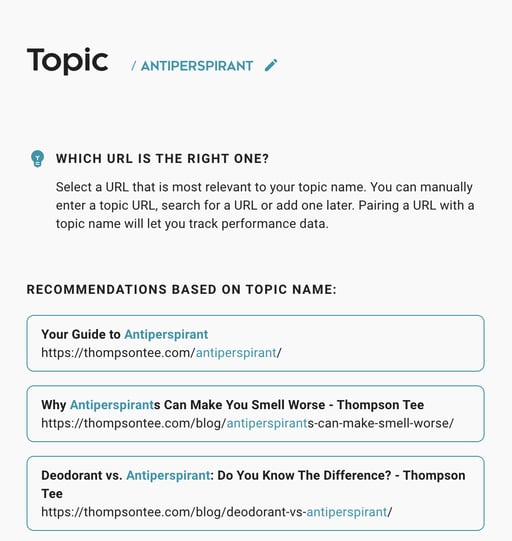
2. Add Supporting Content
Which pages relate to and support your topics? In this step, you’ll add all relevant pages to your topic cluster.
To discover supporting topics, you can export and sort through your URLs. Or, simply navigate to the “Suggested Subtopics” feature in Blueprint SEO to see pages related to your topic.
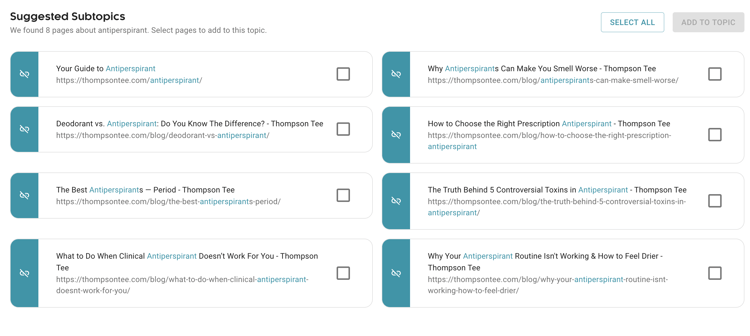
Using the topic editor, you can also search for URLs and quickly drag and drop them to your topic cluster.
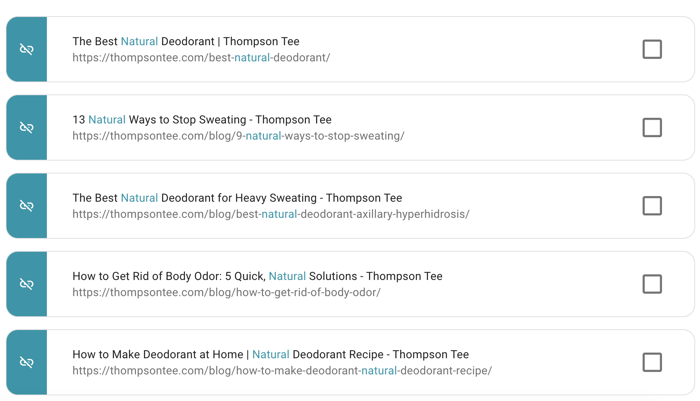
When linking topic cluster content, you can also add links between subtopic pages to help users easily navigate related pages.
3. Link Supporting Content to Their Pillar Page
You’ve grouped related pages. Now, it’s time to link them.
Remember: Internal links pass authority between your topic cluster pages, so this step is critical to establishing hierarchical relationships.
So how can you tell whether links between topic cluster content exist?
Once you’ve grouped your topic clusters in Blueprint SEO, the link icon alerts you to subtopic pages that don’t link to their topic page.
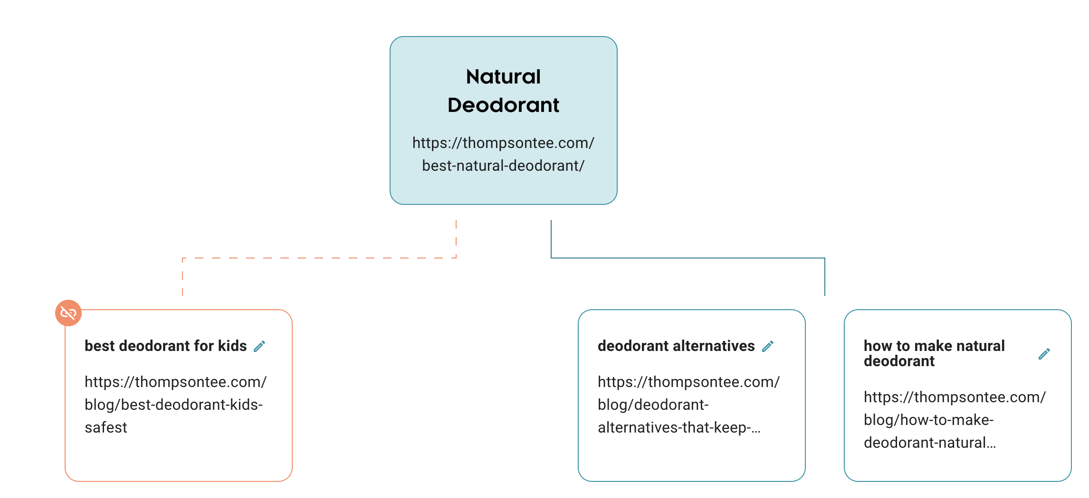
Ensure all subtopic pages link to the topic page, and use descriptive anchor text to fully optimize your internal links.
Simplify Your Internal Linking Strategy With Blueprint SEO
You’ve put hours of research and thought into your internal linking strategy. But how can you make sure it gets implemented without performing regular audits?
Blueprint SEO makes it easy to create and adhere to an internal linking strategy.
The topic cluster tool helps you document your topic cluster strategy and alerts you when links are missing between relevant content.
Try Blueprint SEO free today to start organizing your content!
%20(1)-1.jpg)


